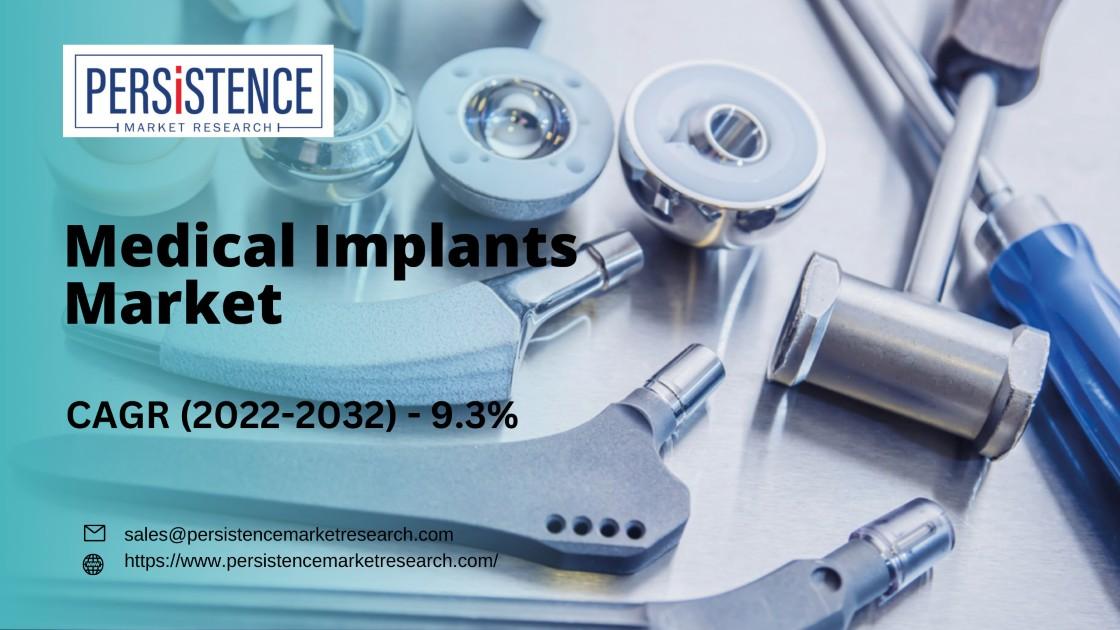GCC Implantable Medical Implants Market:
Pioneering Healthcare Advancements
The global medical implants market is set for substantial growth, projected to rise from approximately US$ 14.75 billion in 2022 to US$ 36 billion by 2032, achieving a robust compound annual growth rate (CAGR) of 9.3%. This growth is driven by several key factors, including the increasing elderly population worldwide, who are more susceptible to chronic diseases necessitating implants such as artificial joints, heart and kidney implants, and eye implants. Moreover, the prevalence of chronic diseases is on the rise globally, further propelling demand for medical implants. Technological advancements in the industry are also enhancing adoption rates. However, challenges such as high implantation costs, inadequate reimbursement policies, and a shortage of skilled healthcare professionals could potentially hinder market expansion in the foreseeable future.

GCC Region Positioned for Significant Growth in Implantable Medical Devices Market
The GCC (Gulf Cooperation Council) region is poised to witness substantial growth in the implantable medical devices market, driven by rising healthcare investments, technological advancements, and a growing demand for innovative healthcare solutions across member states.
Technological Advancements and Healthcare Investments Fuel Market Growth
The GCC countries, comprising Saudi Arabia, UAE, Qatar, Kuwait, Oman, and Bahrain, are making significant strides in healthcare infrastructure development and technological innovation. Investments in advanced medical technologies, including implantable medical devices, are aimed at enhancing healthcare delivery, improving patient outcomes, and reducing the burden of chronic diseases prevalent in the region.
Technological advancements such as 3D printing, biomaterials, and minimally invasive surgical techniques are transforming the landscape of implantable medical devices. These innovations
enable the customization of implants based on patient-specific anatomical data, leading to improved surgical precision, faster recovery times, and enhanced patient satisfaction.
Growing Healthcare Needs and Demographic Trends
The GCC region is experiencing demographic shifts characterized by a growing population, increasing life expectancy, and a rising prevalence of chronic diseases. As the population ages, there is a higher incidence of conditions such as cardiovascular diseases, orthopedic disorders, and diabetes, all of which often require implantable medical devices for treatment and management.
Orthopedic implants, including joint replacements and trauma fixation devices, are in high demand due to sports injuries, accidents, and age-related conditions affecting bone health. Cardiovascular implants such as pacemakers and stents are crucial for managing heart conditions prevalent among the elderly population.
Regional Market Dynamics: UAE and Saudi Arabia Lead Growth
Among the GCC countries, the UAE and Saudi Arabia emerge as key drivers of growth in the implantable medical devices market. These countries boast robust healthcare infrastructure, significant healthcare expenditure, and a strong emphasis on technological innovation in healthcare delivery.
The UAE, in particular, is at the forefront of healthcare innovation with initiatives like Dubai Healthcare City and Abu Dhabi's Vision 2030, which prioritize healthcare sector development and technological integration. Saudi Arabia's Vision 2030 also emphasizes healthcare transformation, aiming to enhance healthcare services, reduce dependence on imported medical devices, and promote local manufacturing capabilities.
Segment Analysis: Orthopedic and Cardiovascular Implants Lead Market Share
Orthopedic implants represent a significant portion of the GCC implantable medical devices market, driven by the region's active population and high incidence of musculoskeletal injuries. The demand for joint replacements, spinal implants, and trauma fixation devices continues to rise, supported by advancements in implant materials and surgical techniques that enhance durability and patient outcomes.
Cardiovascular implants, including pacemakers, stents, and heart valves, are essential for managing cardiovascular diseases prevalent among the GCC population. Innovations in cardiovascular care, such as bioresorbable stents and remote monitoring technologies, contribute to the adoption of advanced implantable devices in the region.
Challenges and Opportunities
Despite the promising growth prospects, the GCC implantable medical devices market faces challenges such as regulatory complexities, healthcare infrastructure disparities among member states, and the need for skilled healthcare professionals. Addressing these challenges requires collaborative efforts from governments, healthcare providers, and industry stakeholders to ensure sustainable growth and patient safety.
However, these challenges also present opportunities for innovation and market expansion. Companies investing in research and development to develop cost-effective implant solutions tailored to regional healthcare needs can capitalize on the growing demand for orthopedic, cardiovascular, and dental implants in the GCC market. Embracing digital health solutions and
telemedicine initiatives further enhances access to specialized healthcare services and improves patient outcomes across the region.
Conclusion
The GCC implantable medical devices market is poised for significant growth driven by technological advancements, rising healthcare investments, and increasing healthcare needs across member states. As governments prioritize healthcare sector development and innovation, the region stands to benefit from improved access to advanced medical technologies and enhanced healthcare delivery.
With a focus on orthopedic, cardiovascular, and dental implants, the GCC region is set to transform healthcare outcomes for its growing population. By leveraging innovation, collaboration, and strategic investments, stakeholders can unlock the full potential of the implantable medical devices market in the GCC, paving the way for a healthier and more prosperous future for the region's residents.
